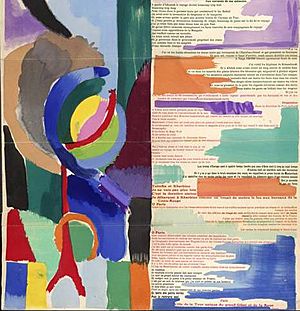La prose du Transsibérien et de la Petite Jehanne de France facts for kids

La prose du Transsibérien et de la Petite Jehanne de France (which means Prose of the Trans-Siberian and of Little Jehanne of France) is a very special book. It was made by two artists working together: the writer Blaise Cendrars and the painter Sonia Delaunay.
The book contains a long poem by Cendrars. It tells the story of a journey across Russia on the famous Trans-Siberian Railway in 1905. This was a time of big changes in Russia, during the first Russian Revolution. Sonia Delaunay added colorful, almost abstract pictures to the poem. She used a special printing method called pochoir.
Published in 1913, this book is seen as a very important work. It helped change how people thought about artists' books. It also influenced modernist poetry and abstract art. One publisher even called it "one of the most beautiful books ever created." Cendrars himself described it as "a sad poem printed on sunlight."
Contents
Meet the Author: Blaise Cendrars
Blaise Cendrars was not his real name. His birth name was Fréderic Louis Sauser. He chose "Cendrars" because it sounded like "ember" (braise) and "ashes" (cendres) in French. He felt that writing was like being burned alive, but also like being reborn from the ashes.
Cendrars was born in Switzerland. When he was 15, he ran away from home. He went to Saint Petersburg in Russia to train as a jeweler. But he loved to travel and explore. He spent important time in New York, where he wrote his first major poem. This poem was called Les Pâques à New York (Easter in New York), published in 1912. After his travels, he settled in Paris, France.
Cendrars' Publishing Adventure
Once in Paris, Cendrars decided to start his own small publishing company. He called it Éditions des Hommes Nouveaux (New Man Editions). He got help from a friend who had a secret printing press. This press was in the Mouzaïa Quarter of Paris.
His first book, Les Pâques à New York, came out in October 1912. He printed 125 copies, but he didn't sell any! Even so, he didn't give up. He quickly started on his second book, La prose du Transsibérien. It was published in June 1913.
He planned to print 150 copies of La prose du Transsibérien. But only about 60 copies were actually printed. Today, only about 30 of those are believed to still exist.
A Book as Tall as the Eiffel Tower
This book is very unusual. It's made of four sheets of paper glued together. They fold out like an accordion. When fully unfolded, the book stands 199 centimeters (almost 2 meters) tall!
Cendrars had a big idea for the book. If all 150 planned copies were unfolded and placed end-to-end, they would reach the height of the Eiffel Tower. The Eiffel Tower was a huge symbol of modern times back then. It is even mentioned in both the poem and the artwork.
The poem tells the story of a 16-year-old poet's journey. He travels by train from Moscow to Harbin in Mongolia. This journey happens during the Russo-Japanese War and the Russian Revolution of 1905. A map at the top of the book shows the route.
The journey is long and difficult. It describes sad scenes of war and revolution. There are descriptions of cold, hunger, death, and destruction. These scenes get worse as the train travels east. The poet's young companion, Jehanne, keeps asking a sad question: "Blaise, are we very far from Montmartre?" (Montmartre is a famous area in Paris).
New Ways with Text and Images
La prose du Transsibérien was one of the first books to use many different fonts. It uses twelve different fonts in various sizes and colors. This was done on purpose to show movement and different feelings. Other artists, like the Italian Futurists, were also experimenting with fonts at this time.
The book is also special because it doesn't look like a traditional book. It places the images and text on equal footing. They run side-by-side and complement each other. The pictures are not just decorations. They are as important as the words.
Simultaneity in Art and Life
Blaise Cendrars met Sonia Delaunay and her husband, Robert Delaunay, through a friend named Guillaume Apollinaire. The Delaunays were important artists in Paris. They were leaders of a new art style called cubism. They also created the idea of Simultaneity.
The Delaunays came up with "Simultaneity" from studying Chevreul's ideas about how colors affect each other. This new style first appeared in April 1912. Robert Delaunay painted a series called Fenêtres (Windows). Soon after, Sonia created her abstract Contrastes Simultanés (Simultaneous Contrasts). Both artists used this bold style for the rest of their careers.
How Simultaneous Contrast Works
The idea is that colors look different depending on the colors next to them. For example, orange next to green looks more red. Green next to orange looks more blue. These constant color influences create a special "vibration" in your eyes.
The Delaunays saw this effect as movement and rhythm. They believed it was the perfect way to paint for a modern world that was always moving.
Robert Delaunay's Windows paintings often featured the Eiffel Tower. These paintings directly influenced Sonia's art in La prose du Transsibérien. The book is designed so your eyes move between the pictures and the words. This creates a feeling of speed and confusion, just like the poem's theme of travel. The book's wrapper even calls it the "first simultaneous book." It also includes a map of Siberia at the beginning, showing the train's route.



